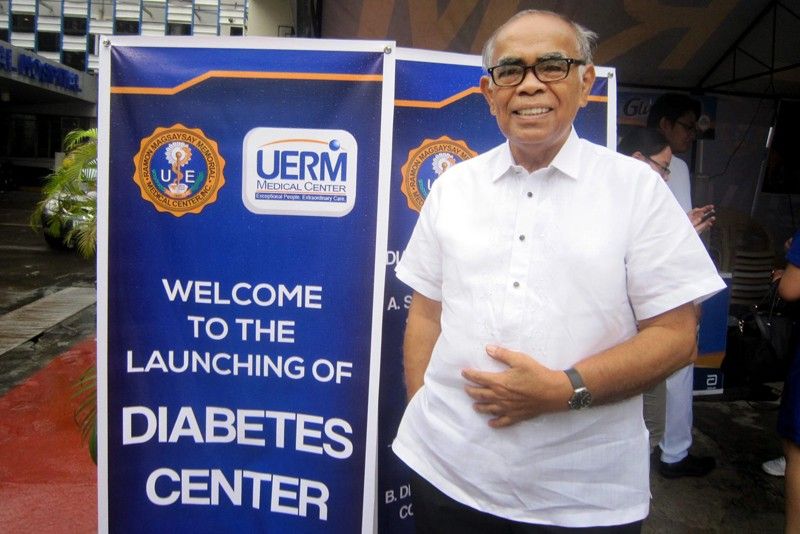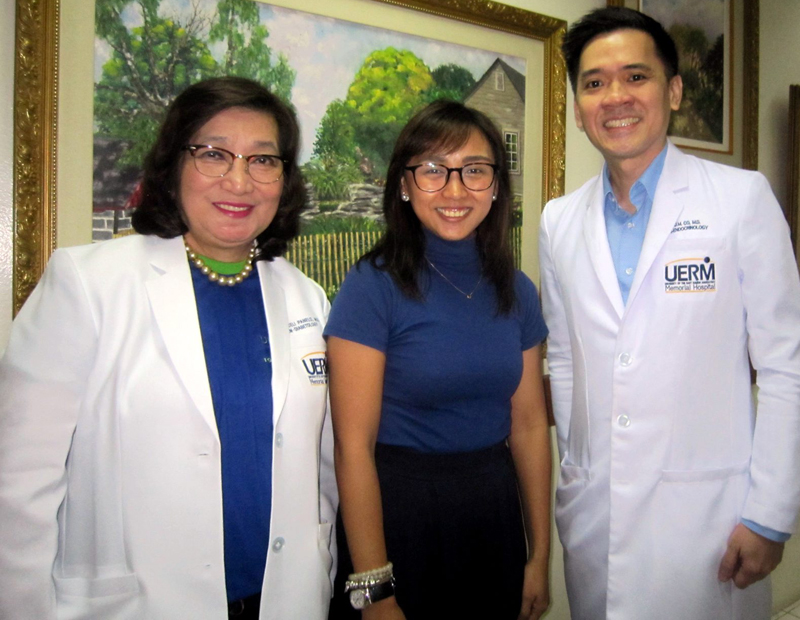At last, a center for Diabetes

MANILA, Philippines — About 6.2 percent of adult Filipinos have diabetes and the number is increasing. “Despite our efforts we are unable to curve the incoming pandemic,” says Dr. Juan Maria Ibarra Co,
UERM Department of Medicine chairman and head of the UERM Diabetes Center. “People are not physically active anymore and unhealthy food is so easy to come by, so they become overweight or obese and pre-disposed to diabetes.” About 31 percent of adult Filipinos are either overweight or obese.
The UERM Medical Center recently inaugurated the UERM Diabetes Center, which is dedicated to patients with diabetes.
“We are launching the program first in our outpatient department (OPD),” Dr. Co explains. “Our endocrinology and diabetes specialists will be there every Thursday afternoon to see patients. As the patient population grows, we hope to make it a daily activity.”
Besides Dr. Co, the consultant staff include Dr. Araceli Panelo, Dr. Hannah Ruth Labajo-Pagaduan, Dr. Michael Rosario and Dr. Celito Tamban.
Blood sugar determination will be done, as well as screening for diabetes complications, including neuropathy, vascular, and eye screening. Lectures will be given on diabetes-related topics such as signs and symptoms, complications, treatment and nutritional advice, weight loss and exercise.
“We plan to establish a Diabetes Club where members can enjoy membership benefits such as cheaper laboratory tests packages,” Dr. Co adds. “We’ll have linkages with pharma companies to provide cheaper medications for the members.”

Dr. Araceli Panelo, Dr. Hannah Labajo, Dr. JM Co
There’s a minimal standard fee of P100 per consultation at the OPD. On the day of the launch, consultations with specialists, as well as the screening tests were given free. Capillary blood sugar determination was done by Bayer, while Abbott provided sampling of Glucerna a nutritional supplement.
The food that we eat is digested and turned to sugar or glucose, which passes through the blood stream and goes to the muscle and fat cells and become energy in the body. Insulin, which is produced by the pancreas, is the key that opens up the cells so sugar can enter. In this way, blood sugar is regulated in our body.
There are two types of diabetes. Type 1 diabetes, which often has its onset during childhood, develops when the pancreas fails to produce insulin, which is the primary hormone that regulates blood sugar. Type 2 diabetes results when insulin is not accepted by the muscle and fat cells resulting in the accumulation of sugar in the blood stream.
Diabetes is a chronic disease of elevated blood sugar or hyperglycemia, an excess of glucose in the blood stream. If uncontrolled, it may lead to complications such as kidney damage, lower limb amputations, blindness or even stroke or heart attack.
“Filipinos are genetically pre-disposed and at high risk of getting diabetes,” says diabetologist Dr. Araceli Panelo, who holds her clinic at UERM. “About 80 percent of diabetes patients have stroke.”
“The first thing I ask when the patient has stroke or heart attack is, do you have diabetes?” says Dr. Joven Cuanang, neurologist and trustee of the board at UERM Medical Center, who founded the Stroke Society of the Philippines. “Brain attack, like heart attack, is anchored on diabetes. So if we can control diabetes mellitus, I think we would be able to control the incidence of stroke and heart attack, which are the most important causes of morbidity and mortality in the Philippines and in fact in the whole world. ”
“One of the universities that pioneered in diabetes is UERM because of Dr. Ricardo Fernando, the foremost diabetes specialist in the country,” says Dr. Cuanang. “Given the historical development of how the institution promoted awareness of diabetes a long time ago, we thought that UERM should be known for it. So that’s the take-off of everything that we are doing now.”
“UERM had the first Diabetes Clinic in the Philippines, which was started by Dr. Fernando in the 1960s. He went to train at Joslin Clinic in Boston, a world-renowned diabetes center. Being the visionary that he was, he saw that diabetes would spread and become prevalent in the country. He started training residents of Internal Medicine of different hospitals and saw that they had a craving to learn more, so he formalized the training in the 1980s,” Dr. Panelo relates. Dr. Fernando created the first program offering of the UERM Graduate School, which was the Master of Science in Internal Medicine with major in Diabetology.
“We have long been known in the academic circles as being good in diabetes,” Dr. Panelo says. “We have a memorandum of agreement with the Institute for Studies on Diabetes Foundation that train doctors from the provinces especially in diabetes care.”
“We want UERM to be the center for diabetes. That is the vision,” says Dr. Cuanang. “The strategy for disease prevention and health promotion is public education. It should be a sustained effort. Our research should also focus on diabetes.”

Capillary blood glucose or random blood sugar determination
“What we really want to know is how to prevent diabetes, since it is difficult when you already have it. It cannot be cured. It can only be controlled,” says Dr. Jennifer Nailes, VP for research and director for research, education and training. “We study the epidemiology, the distribution patterns and conditions of afflicted populations. By analyzing their profile, those overweight, for example, and addressing them, we may be able to prevent the disease. We have studies on the treatment, both pharmacologic i.e. drugs and non-pharmacologic or lifestyle change. We’re also looking at herbals.”
“Patients skip their medication and buy herbal supplements due to the popularity of celebrity endorsements,” Dr. Panelo observes.
However, Dr. Co remarks, “Testimony is the very weakest form of evidence.” Dr. Nailes says, “It’s important that it’s proven by science.”
The common symptoms of diabetes include frequent urination, always thirsty, always hungry and weight loss. Tingling sensation and numbness or easily tired and sleepiness may also be associated with high blood sugar levels. However, the symptoms may not be felt in the early stage. It can take up to 10 to 15 years to cause complications.
According to a study by the World Health Organization, five percent of world blindness is secondary to diabetic retinopathy. “After 20 years,” Dr. Job Dumapig, chief resident at UERM department of ophthalmology noted, “60 percent of patients diagnosed with type 2 diabetes and 99 percent with type 1 diabetes will demonstrate some degree of diabetic retinopathy, a diabetes complication caused by damage to the blood vessels of the light-sensitive tissue at the back of the eye or the retina.”
“The management of diabetes is three-pronged: diet, exercise, and medication,” says Dr. Cuanang.
He thinks fast food and eat-all-you-can buffets are culprits in Filipinos’ poor eating habits. He shares a few practical tips: “Chew your food at least 30 times before swallowing. Stop before you feel full. Drink eight to 10 glasses of water every day. Learn to say no. It is important to control stress.”
Lack of physical activity is another risk factor, especially now that so much time is spent in front of the computer and electronic gadgets. It is said that “sitting is the new smoking.” Take a break from your computer for at least 10 minutes every hour. Exercise at least 30 minutes a day, five days a week.
“The most important thing is to be aware that patients with diabetes are increasing in number and it chooses no age,” Dr. Labajo says. “It’s sad to find young patients in their 20s who already have type 2 diabetes. And they are the ones who are difficult to manage because of their lifestyle — some work the night shift in BPOs, they are used to going out with their friends, eating fast food, smoking, drinking soft drinks — and then suddenly you tell them that they have diabetes and need to change. They are the ones you want to catch and control early because they still have years ahead that they will have to deal with diabetes. They are the ones who have early stroke, early heart attack, even early death, and we want to prevent that.”
“Diabetes is a lifestyle disease. We have to create awareness for people to get tested early on. The goal of the management of diabetes is to prevent the complications. The key is prevention. What we want to happen in the future is to prevent patients developing type 2 diabetes by promoting a healthy lifestyle,” Dr. Labajo remarks. “Health is wealth.”


















